
- Giving you critical information to confidently diagnose and treat Heart Failure with preserved ejection fraction (HFpEF).
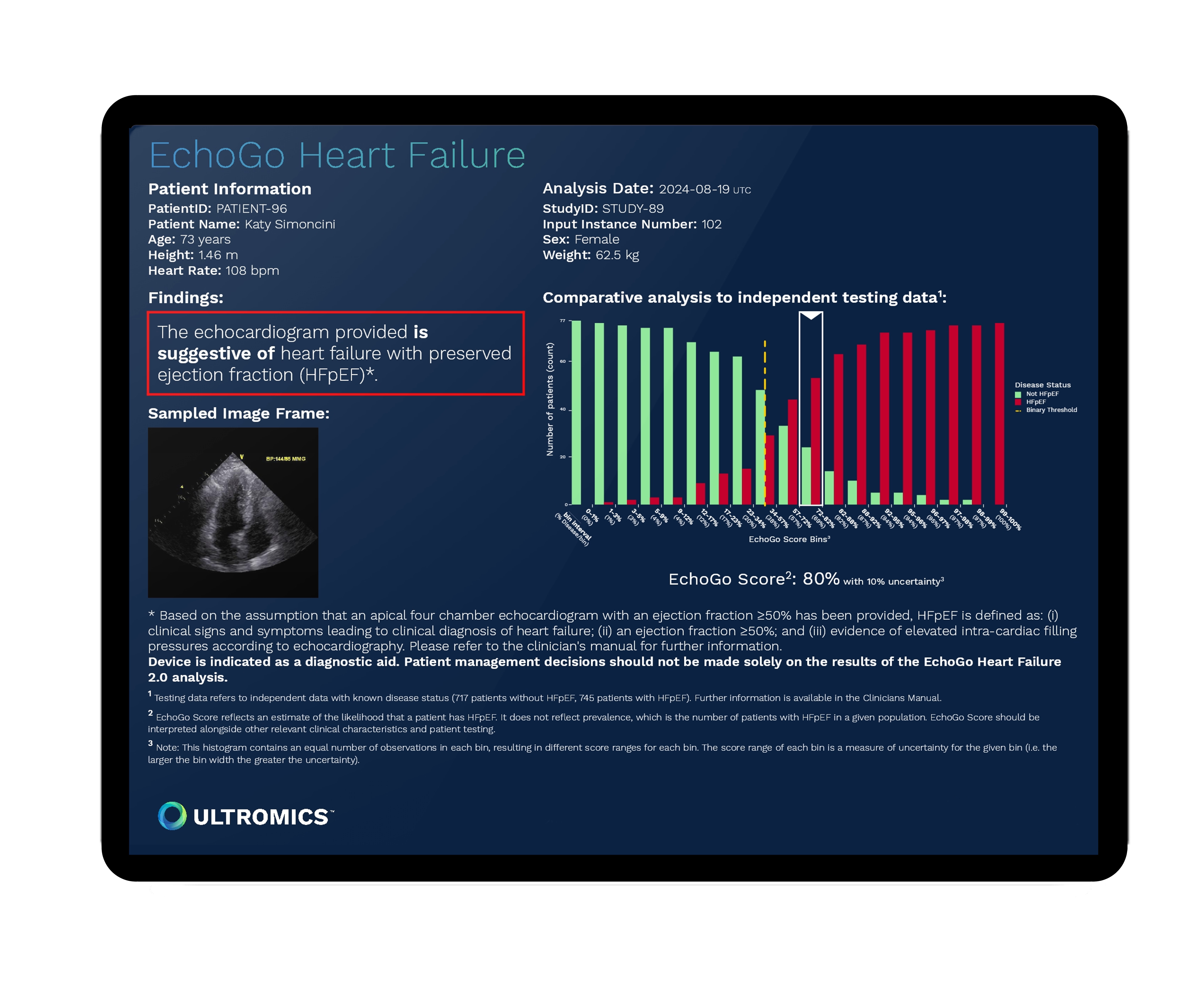

EchoGo® Heart Failure
EchoGo® Heart Failure is an FDA-cleared, AI-enabled medical device indicated as a diagnostic aid to support the detection of HFpEF. It uses deep learning to analyze a single apical 4-chamber echocardiographic clip and provides structured insights to assist clinicians during the diagnostic workup.

FDA Breakthrough Technology
The FDA cleared EchoGo® Heart Failure follows a clinical study that demonstrated its safety and efficacy. The results demonstrated excellent discrimination between patients with and without HFpEF.
We are proud to partner with the FNIH as part of The Accelerating Medicines Partnership® Heart Failure (AMP® HF), working alongside public and private sector companies, including the NIH National Heart, Lung and Blood Institute and the American Society of Echocardiography. Together, we are working to solve the complications surrounding HFpEF detection, which is crucial for the delivery of effective therapies and the improvement of patient outcomes.
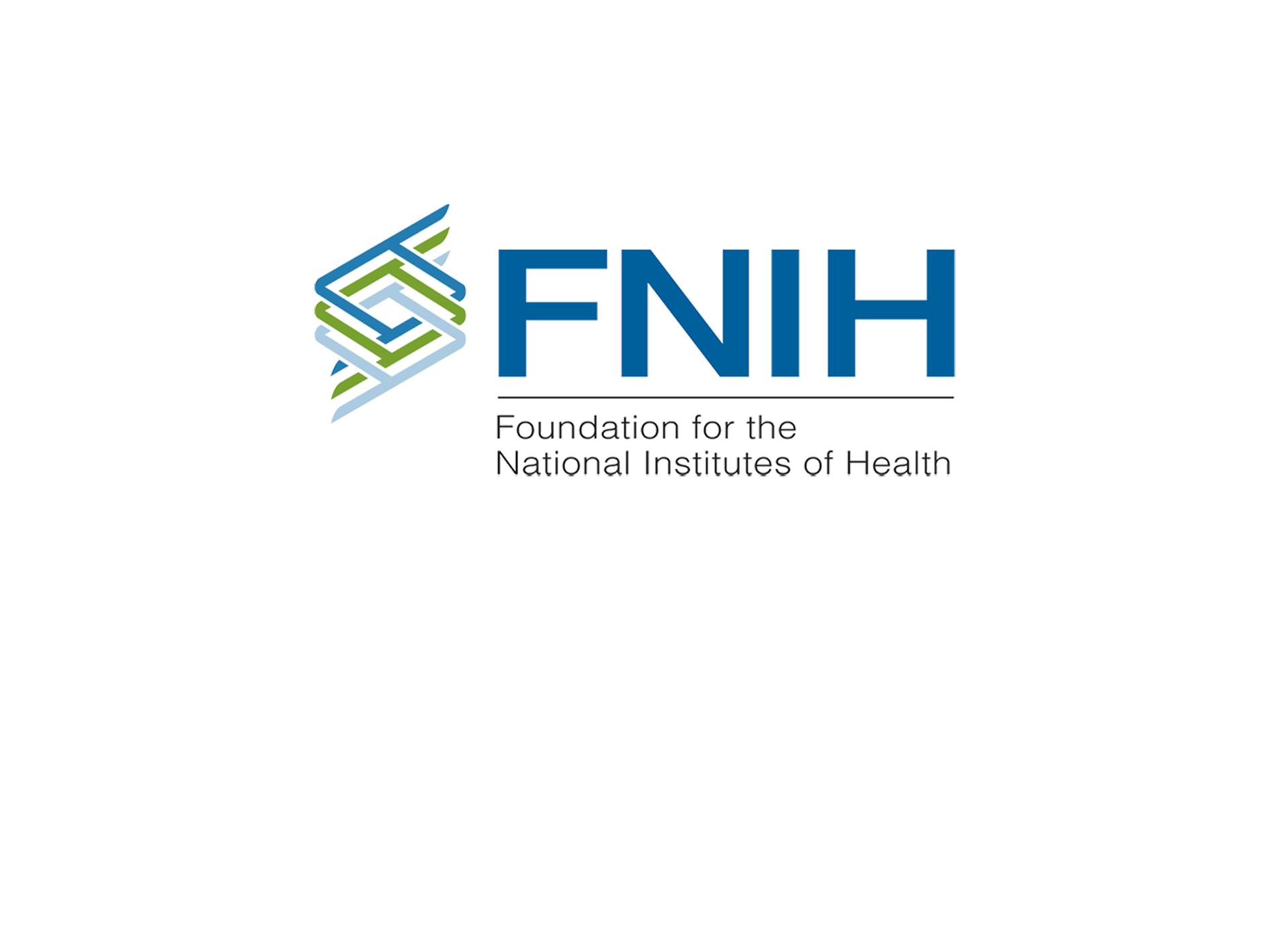
Get more clarity diagnosing HFpEF
As individuals age, myocardial function may decline, resulting in cardiac dysfunction and subsequent heart failure. This dysfunction may manifest in two distinct forms: Heart Failure with Reduced Ejection Fraction (HFrEF), characterized by inadequate blood pumping, and Heart Failure with Preserved Ejection Fraction (HFpEF), marked by insufficient ventricular filling. While the assessment of reduced ejection fraction is relatively straightforward, accurately evaluating diastolic function associated with HFpEF, poses a considerable challenge. Despite ultrasound's capacity to visualize systolic function, accurately assessing diastolic filling remains complex and requires meticulous evaluation.
"Understanding what HFpEF is, when it happens, and how to treat it remains the single largest unmet need in cardiovascular health."
National Institutes of Health
Large Global Burden
Heart failure impacts 64 million worldwide, with HFpEF accounting for half of all cases [1,2,3]
No. 1 Cost of Hospitalization
$43B in 2020, increasing to $69B in 2030 [4]
High Readmission Rates and Substantial Morbidity
5 year readmission rates: 84% [5]
5 year readmission mortality rates: 75.7% [5]

Diagnosis Remains Challenging
Unclear patient presentation
~50% of patients have 5+ major comorbidities, often sharing common signs and symptoms. [7]
Comorbid conditions
Often affect diagnostic measurements, requiring specialist sonographers. [8]
Confounding disease characteristics
Lack of uniformity in disease definition. [8]
Limited access to specialized care
Inconsistent access to HF cardiologists and clinics.
Improving Diagnosis is Crucial
While transthoracic echocardiography (TTE) is routinely used to estimate intracardiac filling pressure, there is considerable variability in its performance and interpretation, imposing a heavy burden on skills, time, and expertise. Clinical algorithms have been proposed in clinical guidelines but can be hindered by discordant or incomplete information, resulting in variable diagnostic capacity and adding burden. Up to 64% of HFpEF patients may be undiagnosed. [6]
"There remains no readily available gold standard diagnostic test, with the diagnosis of HFpEF largely one of exclusion."

Emerging Therapies for HFpEF Treatment
- Strong evidencen for the use of sodium–glucose cotransporter type 2 (SGLT2) inhibitors in the treatment of HFpEF. [10, 11]
- SGLT2i Empagliflozin can reduce hospitalizations by 29% in HFpEF patients [10]
- Efficient and accurate diagnosis is needed to match patients to these new therapies.
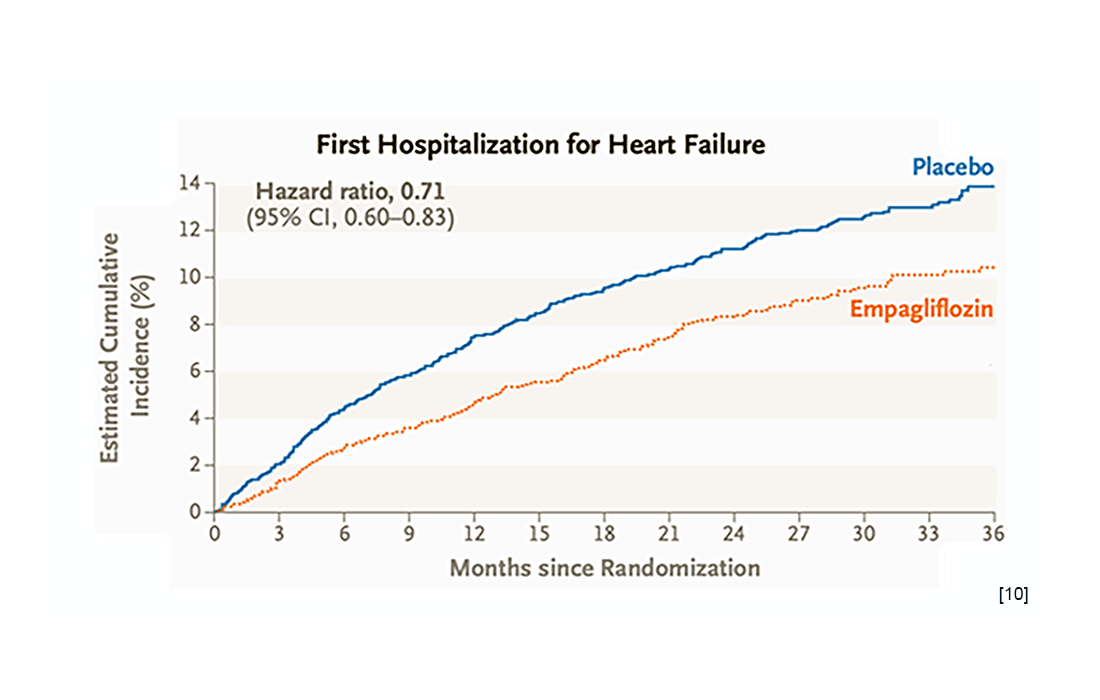
EchoGo® Heart Failure
EchoGo® Heart Failure is FDA-cleared device indicated as a diagnostic aid to support detection of HFpEF. It highlights suspected disease findings via reports delivered to physician workstations within 30 minutes—supporting smart, timely clinical decision-making.
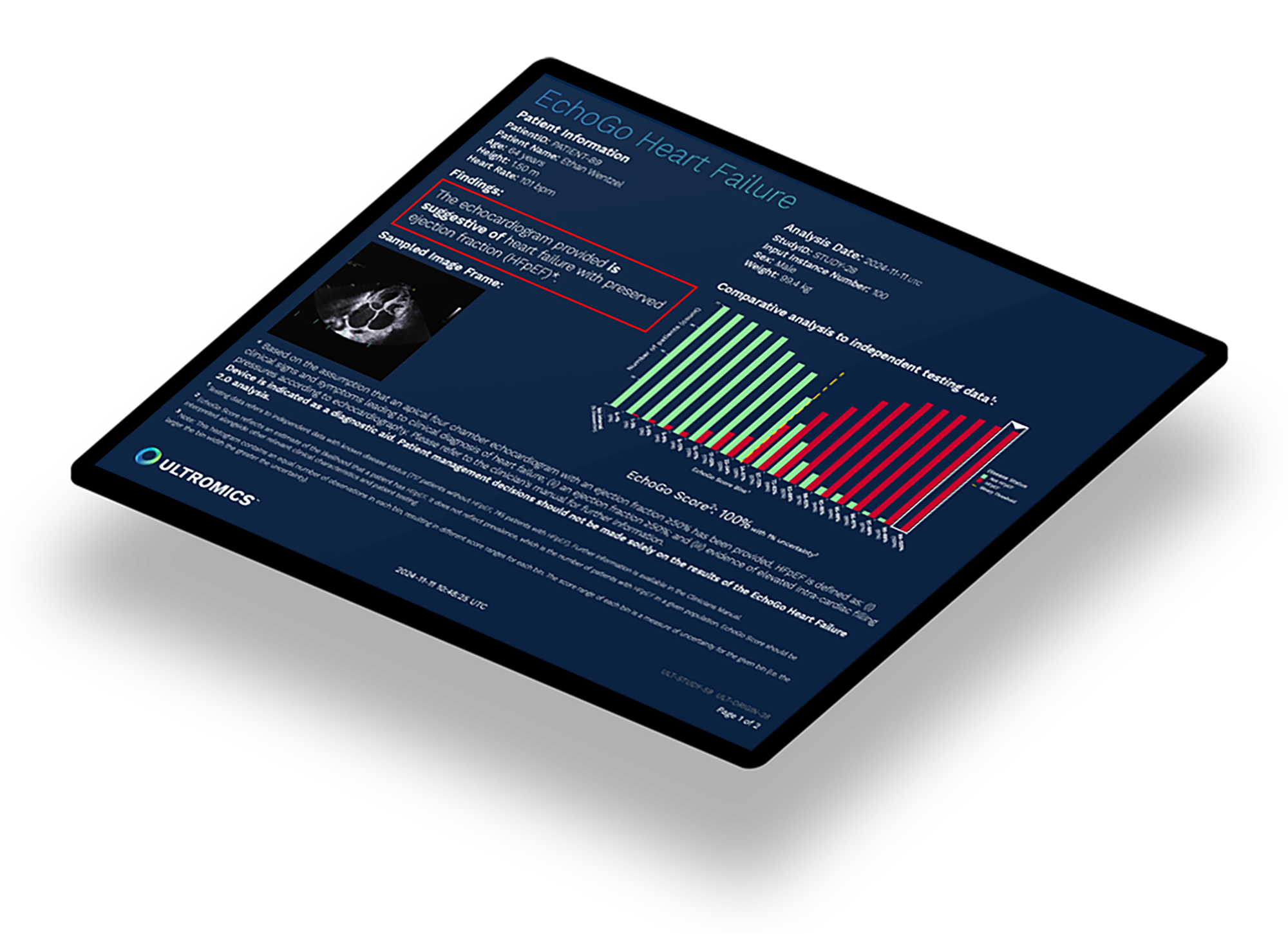
of patients classified as indeterminate without EchoGo® Heart Failure
of HFpEF patients classified as indeterminate with EchoGo® Heart Failure 12
"This novel solution applies AI to cardiovascular imaging to greatly simplify the identification of HFpEF patients, a diagnosis that can be challenging, and allows more expeditious treatment."
Patricia A. Pellikka, M.D., Vice Chair, Department of Cardiovascular Medicine at Mayo Clinic

Real-world Validation
EchoGo® Heart Failure is a product of collaborative innovation, developed with the esteemed Mayo Clinic and rooted in the academic excellence of the University of Oxford. The technology has undergone rigorous real-world testing across diverse medical sites, delivering unparalleled accuracy in identifying disease. Customers include Indiana University, Northwestern University, City of Hope, and University of Wisconsin.

Reclassify >73% of non-diagnostic results
An independent study of 1,284 patients, conducted by Mayo Clinic and published in JACC: Advances, confirmed that EchoGo® Heart Failure improved classification of previously non-diagnostic cases when compared to HFA-PEFF and H2FPEF scores
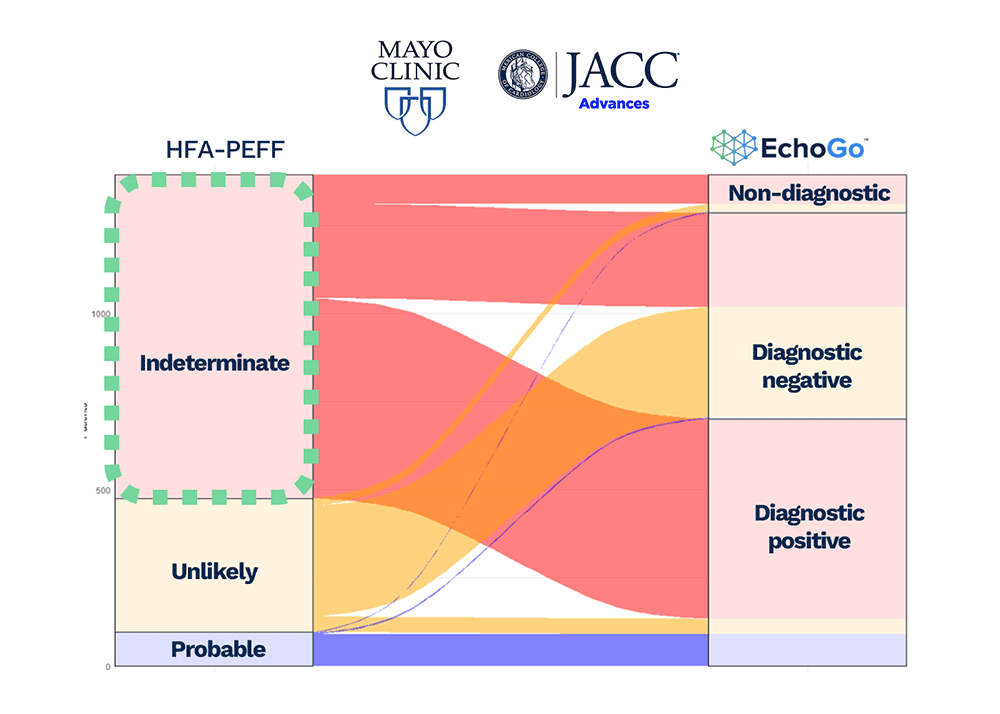
Identify high-risk patients
The diagnostic positive (HFpEF) had a 90% higher probability of dying over the 5 years. These cases have the opportunity for therapeutic intervention. [12]
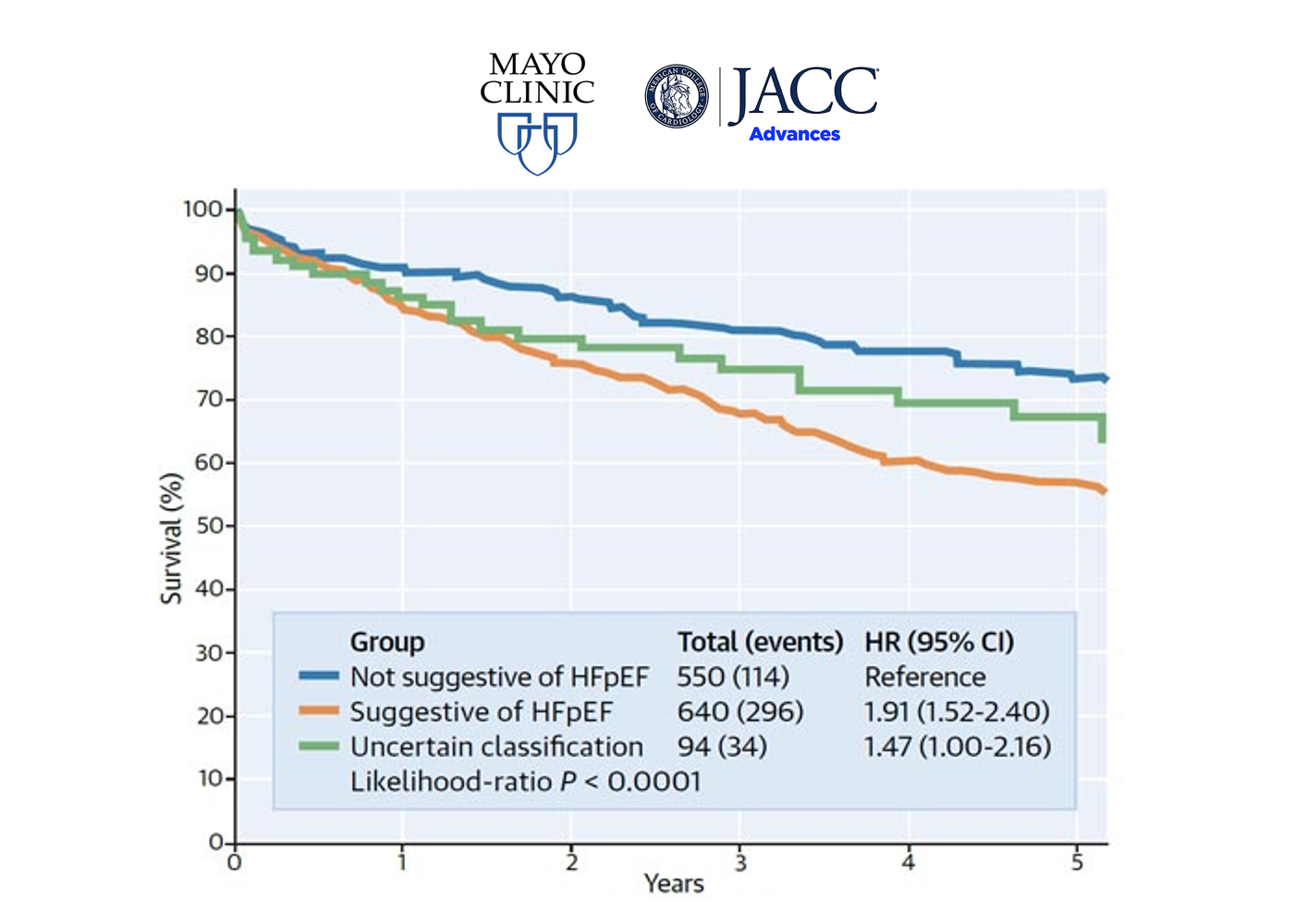
See our validation and proof
EchoGo® Heart Failure is Reimbursable
- For inpatient settings, NTAP code ICD-10: XXE2X19 provides $1000 per analysis, covered by Medicare.
- In outpatient settings, HCPCS code C9786 and Clinical APC 5743 offers $284.88 per analysis.

Built on the EchoGo® platform
Any vendor
Connects with any vendor in any care setting.
Dashboard
Customer report dashboard and smart analytics.
QC + secured
CyberEssentials, ISO 27001, and ISO 13485. HIPAA Compliance.
No training
No need to learn software. Always being optimized.
Seamless
Simple and easy integration that fits with your workflow.
Cloud native
Operate on a cloud native architecture for optimal resource saving.
Integrated into Your Workflow
EchoGo® embeds reports directly into your reading workflow through a secure cloud-based server:
- DICOM Secondary Capture
- DICOM SR
- EMR Integration
Interested in how EchoGo® Heart Failure integrates into your workflow?
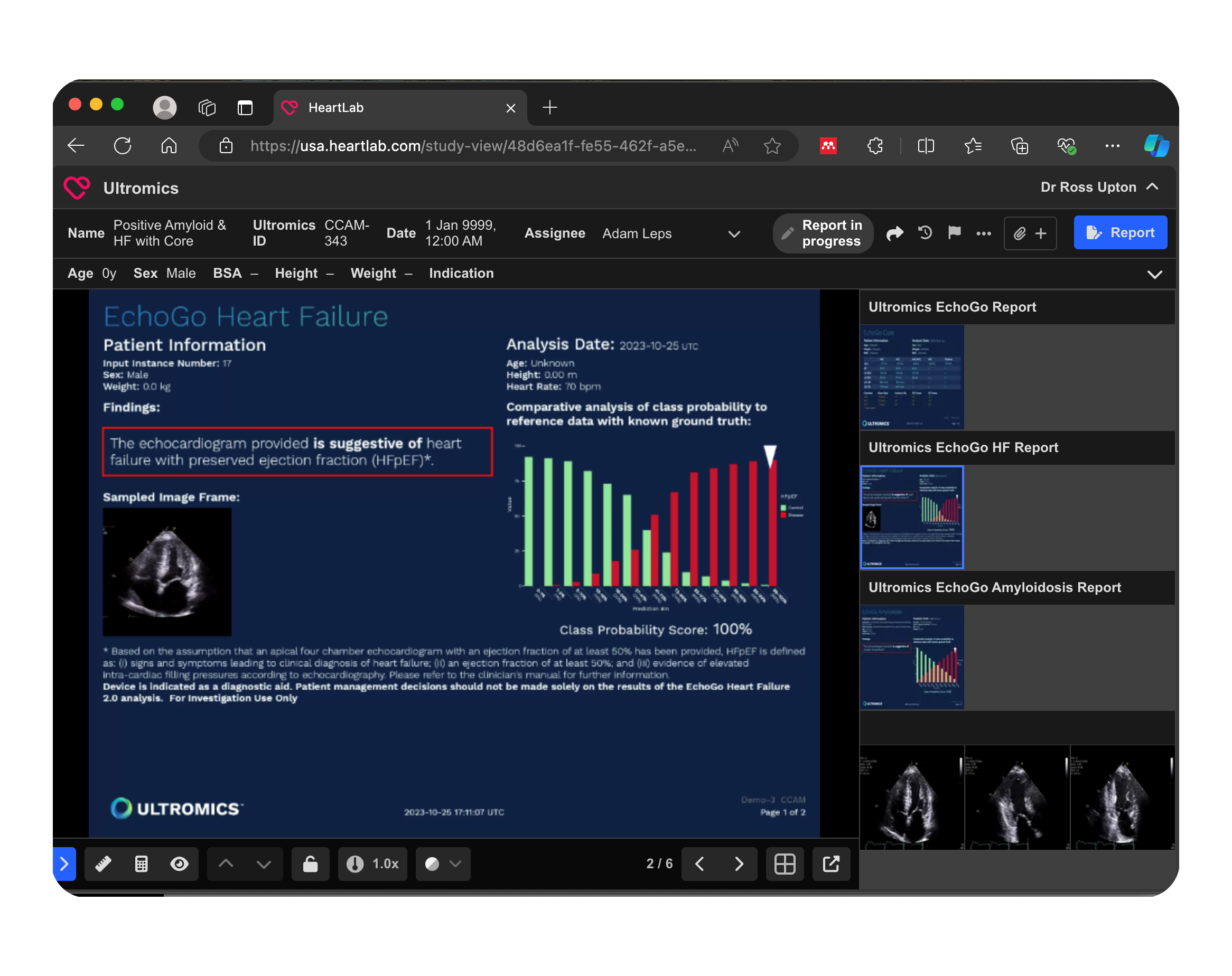
Pioneering Technology
Get in touch
We're here to showcase how our innovative solution can enhance your cardiac diagnostics. Reach out to us to learn more.

References:
- Groenewegen A, et al. Epidemiology of heart failure. European Journal of Heart Failure [Internet]. 2020;22(8):1342–56.
- Tsao CW, et al. Heart Disease and Stroke Statistics—2022 Update: A Report From the American Heart Association. Circulation [Internet]. 2022;145(8).
- Pfeffer MA, Shah AM, Borlaug BA. Heart Failure With Preserved Ejection Fraction In Perspective. Circulation Research. 2019;124(11):1598–617.
- Heidenreich PA, et al. Forecasting the Impact of Heart Failure in the United States: A Policy Statement From the American Heart Association. Circulation: Heart Failure [Internet]. 2013;6(3):606–19.
- Bozkurt B, et al. Heart Failure Epidemiology and Outcomes Statistics A Report of the Heart Failure Society of America. Journal of Cardiac Failure. 2023;29(10).
- Borlaug BA, Sharma K, Shah SJ, Ho J. Heart Failure With Preserved Ejection Fraction. Journal of the American College of Cardiology. 2023;141(12):1001-1026
- Dunlay SM, Roger VL, Redfield MM. Epidemiology of heart failure with preserved ejection fraction. Nature Reviews Cardiology [Internet]. 2017;14(10):591–602.
- Ho JE, et al. Deliberating the Diagnostic Dilemma of Heart Failure With Preserved Ejection Fraction. Circulation. 2020;142(18):1770–80.
- Heidenreich PA, et al. 2022 AHA/ACC/HFSA guideline for the management of Heart Failure: A Report of the American College of Cardiology/American Heart Association Joint Committee on Clinical Practice Guidelines. Circulation [Internet]. 2022;145(18).
- Anker SD, et al. Empagliflozin in Heart Failure with a Preserved Ejection Fraction. New England Journal of Medicine. 2021;385(16).
- Solomon SD, et al. Dapagliflozin in Heart Failure with Mildly Reduced or Preserved Ejection Fraction. New England Journal of Medicine [Internet]. 2022;387:1089-1098
- Akerman AP, et al. Automated Echocardiographic Detection of Heart Failure With Preserved Ejection Fraction Using Artificial Intelligence. JACC. 2023;2(6):100452–2.